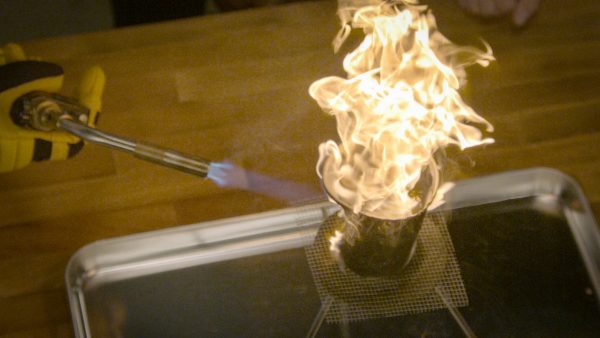Convection Definition
Convection transfers thermal energy through fluid circulation. For example, heated water rises as cooler water moves to replace it.
View Lesson on Heat: Transfer of Thermal Energy
Become a member to get full access to our entire library of learning videos, reading material, quiz games, simple DIY activities & more.
Become a member to get full access to our entire library of learning videos, quiz games, & more.
Plans & Pricingto watch this full video.

Access All Videos
and Lessons, No Limits.
Access All Videos

No credit card required,
takes 7 sec to signup.
No card required

Ready-to-go lessons
that save you time.
Ready-to-go lessons
If you are on a school computer or network, ask your tech person to whitelist these URLs:
*.wistia.com, fast.wistia.com, fast.wistia.net, embedwistia-a.akamaihd.net
Sometimes a simple refresh solves this issue. If you need further help, contact us.
Heat: Transfer of Thermal Energy
Fun Facts
- Heating air causes it to rise, then cool and sink, forming a convection current.
- Water at the bottom of a pot rises when heated by convection, then sinks as it cools.
- Convection is used in heating homes by causing air near heaters to circulate.
Why Do We Need To Know About Convection
Learning about convection helps us know how heat moves around us and is important for making things like heaters work better. Knowing about convection can lead to jobs in designing air conditioning and heating systems.
Convection is key for making new, energy-saving technologies, better ways to cook, and fun stuff like hot air balloons. So, convection is really useful in many areas.
Frequently Asked Questions
Check out the Full Lesson on Heat: Transfer of Thermal Energy
In this lesson, we learn that:
- Heat is the transfer of thermal energy from one object to another.
- Heating can occur by conduction, convection and radiation.
- Some materials can store more thermal energy than others.
Related Topics
- Body Fossils Definition
- Circulatory System Definition
- Coastal Erosion Definition
- Conduction Definition
- Convection Definition
- Corona Definition
- DNA Definition
- Decomposer Definition
- Definition Of Extreme Weather
- Definition Of Living Things
- Digestive System Definition
- Divergent Boundary Definition
- Earth’s Axis Definition
- Energy Conversion Definition
- Energy Definition
- Energy Transfer Definition
- Extinct Definition
- Fossil Definition
- Fresh Water Definition
- Germination Definition
- Heat Definition
- Heating And Cooling Definition
- Hydrosphere Definition
- Limited Resource Definition
- Metamorphosis Definition
- Molecule Definition
- Motion Definition
- Natural Selection Definition
- Offspring Definition
- Opaque Definition
- Pollination Definition
- Pollution Definition
- Property Definition
- Pulley Definition
- Push Definition
- Reproduction Definition
- Scientific Name Definition
- Sediment Filter Definition
- Snow Definition
- Solar Eclipse Definition
- Solar System Definition
- Temperature Definition
- Trace Fossil Definition
- Transform Boundary Definition
- Water Erosion Definition
- Wavelength Definition
- Weather Definition
- Weathering Definition
Start a Free Trial Today. Get a $5 Amazon Gift Card!
Teachers! Start a free trial & we'll send your gift card within 1 day. Only cards left. Try it now.
Select Grade
Select Subject
This email is associated with a Science Kit subscription. Kit subscriptions are managed on this separate page: Manage Subscription

-
Download InvoiceScience & Math$/yr
-
Download InvoiceScience Only$/yr

access all lessons
• No credit card required •
"My students loved the videos. I started the video subscription in May and used them as a review before the state test, which I know contributed to 100% of my class passing the state test."
Rhonda Fox 4th Grade Teacher, Ocala, Florida
• No credit card required •
"My students loved the videos. I started the video subscription in May and used them as a review before the state test, which I know contributed to 100% of my class passing the state test."
Rhonda Fox 4th Grade Teacher, Ocala, Florida
• No credit card required •
Already a member? Sign In
* no credit card required *

* no credit card required *
* no credit card required *


no credit card required
Skip, I will use a 3 day free trial
Enjoy your free 30 days trial
-
Unlimited access to our full library
of videos & lessons for grades K-5. -
You won’t be billed unless you keep your
account open past your 14-day free trial. -
You can cancel anytime in 1 click on the
manage account page or by emailing us.
-
Unlimited access to our full library of videos & lessons for grades K-5.
-
You won't be billed unless you keep your account open past 14 days.
-
You can cancel anytime in 1-click on the manage account page.
Cancel anytime in 1-click on the manage account page before the trial ends and you won't be charged.
Otherwise you will pay just $10 CAD/month for the service as long as your account is open.
Cancel anytime on the manage account page in 1-click and you won't be charged.
Otherwise you will pay $10 CAD/month for the service as long as your account is open.
We just sent you a confirmation email. Enjoy!
DoneWe use cookies to make your experience with this site better. By using this site you agree to our use of cookies. Click "Decline" to delete and block any non-essential cookies for this site on this specific property, device, and browser. Please read our privacy policy for more information on the cookies we use.Learn More
We use cookies to improve your experience. By using this site, you agree to our use of cookies. Click "Decline" to block non-essential cookies. See our privacy policy for details.Learn More




























































































































